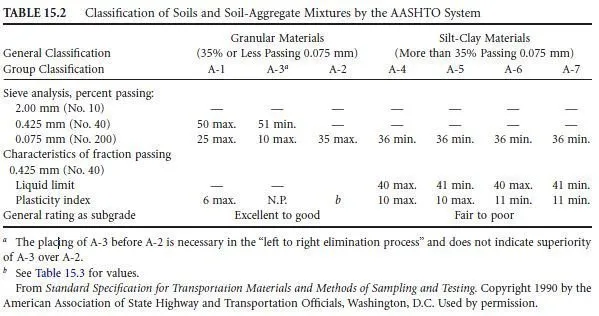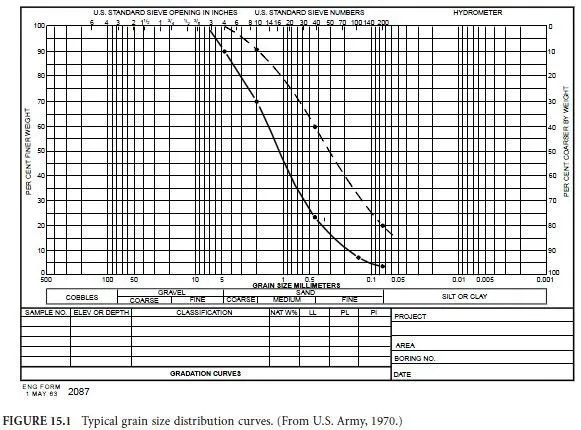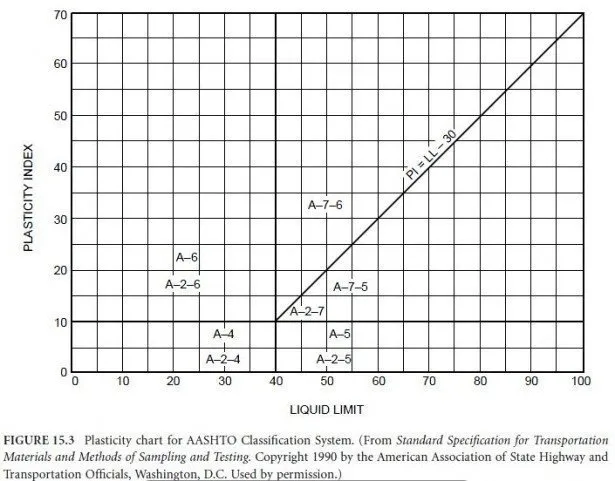The AASHTO system classifies soils into seven primary groups, named A-1 through A-7, based on their relative expected quality for road embankments, subgrades, subbases, and bases. Some of the groups are in turn divided into subgroups, such as A-1-a and A-1-b. Furthermore, a group index may be calculated to quantify a soils expected performance within a group.
To determine a soils classification in the AASHTO system, one first determines the relative proportions of gravel, coarse sand, fine sand, and silt-clay. In the AASHTO system gravel is material smaller than 75 mm (3 in.) but retained on a No. 10 sieve; coarse sand is material passing a No. 10 sieve but retained on a No. 40 sieve; and fine sand is material passing a No. 40 sieve but retained on a No. 200 sieve. Material passing the No. 200 sieve is silt-clay and is classified based on Atterberg limits. It should be noted that the division between gravel and sand is made at a smaller size (No. 10 sieve) in the AASHTO system than in the unified system (No. 4 sieve). Secondly, if any fines are present, Atterberg limits are determined and the plasticity index is calculated.
A soil is a granular material if less than 35% of the soil by weight passes the No. 200 sieve. Granular materials are classified into groups A-1 through A-3. Soils having more than 35% passing the No. 200 sieve are silt-clay and fall in groups A-4 through A-7.
Having the proportions of the components and the plasticity data, one enters one of the two alternative AASHTO classification tables (Tables 15.2 and 15.3) and checks from left to right until a classification is found for which the soil meets the criteria. It should be noted that, in this scheme, group A-3 is checked before A-2. The AASHTO plasticity criteria are also illustrated in Fig. 15.3.

Soils classified as A-1 are typically well-graded mixtures of gravel, coarse sand, and fine sand. Soils in subgroup A-1-a contain more gravel whereas those in A-1-b contain more sand.
Soils in group A-3 are typically fine sands that may contain small amounts of nonplastic silt. Group A-2 contains a wide variety of borderline granular materials that do not meet the criteria for groups A-1 or A-3. Soils in group A-4 are silty soils, whereas those in group A-5 are high-plasticity elastic silt. Soils in group A-6 are typically lean clays, and those in group A-7 are typically highly plastic clays. Within groups containing fines, one may calculate a group index to further evaluate relative quality and supporting value of a material as subgrade. The group index is calculated according to the following empirical formula:
Group index = (F 35)[0.2 + 0.005(LL 40)] + 0.01(F 15)(PI 10)
In this equation F is the percentage of fines (passing the No. 200 sieve) expressed as a whole number.
When calculating the group index for A-2-6 and A-2-7, only the PI term is used. The group index is rounded to the nearest whole number and, if negative, it is taken as zero. The expected performance is inversely related to group index. A value of zero indicates a good subgrade material and a value above 20 indicates a very poor material.

